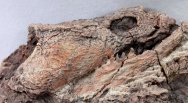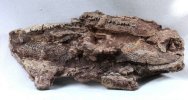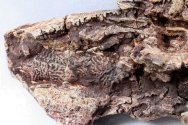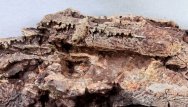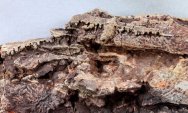Seymouria
baylorensis
Conybeare, 1822
Phylum
Chordata, Order Seymouriamorpha, Family Seymouriidae
Geological
Time: Lower Permian Leonardian Stage (~275 million years ago)
Size (25.4
mm = 1 inch): Fossil is 97 mm long by 45 mm high by 30 mm deep Matrix:
150 mm by 65 mm
Fossil Site:
Clear Fork Formation, Baylor County, Texas USAm
Fossil Code:
SRC19
Price: Sold
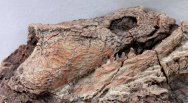 This
specimen displays the right side of the skull and mandible of
the amphibian Seymouria baylorensis. The genus and species names
are derived from the type location of Seymour in Baylor County
Texas. Once thought to be an amniote and member of the stem group
of the Tetrapoda, they are currently considered to be members
of the last group to precede the origin of the amniotes. They
laid eggs in the water which hatched and ultimately metamorphosed
into the adult form known so well. While no known larvae have
been found, the close relative Discosauriscus (see my other postings)
is known only from the larval form. The reverse shows many skull
and jaw fragments associated from the left side of the head,
affording an interesting example of this amphibian that spent
quite of bit of its existence on the land. This
specimen displays the right side of the skull and mandible of
the amphibian Seymouria baylorensis. The genus and species names
are derived from the type location of Seymour in Baylor County
Texas. Once thought to be an amniote and member of the stem group
of the Tetrapoda, they are currently considered to be members
of the last group to precede the origin of the amniotes. They
laid eggs in the water which hatched and ultimately metamorphosed
into the adult form known so well. While no known larvae have
been found, the close relative Discosauriscus (see my other postings)
is known only from the larval form. The reverse shows many skull
and jaw fragments associated from the left side of the head,
affording an interesting example of this amphibian that spent
quite of bit of its existence on the land.
Reference: Paleobios, Vol 17, No 1, July 13 1996, pp1-16.
|
|


